Preliminary Safety Analysis of Megaconstellations in Low Earth Orbit: Assessing Short-Term and Long-Term Collision Risks
Abstract
1. Introduction
2. Short-Term and Long-Term Collision Probability Calculation Models
2.1. Short-Term Collision Probability Calculation Model
2.1.1. Apogee–Perigee Filtering
2.1.2. Time Window Filtering
2.1.3. Spatial Discrete Volume Element Proximity Analysis
2.1.4. Relative Position Filtering
2.1.5. Proximity Analysis Based on Lagrangian Interpolation
2.1.6. Collision Probability Calculation Model
2.2. Long-Term Collision Probability Calculation Model
2.2.1. Model-Simplifying Assumptions
2.2.2. Space Object Density Calculation Model
2.2.3. Space Debris Attenuation Model
2.2.4. Space Target Collision Disintegration Model
3. Simulation Results and Analysis
3.1. Simulation and Analysis of Short-Term Collision Probability
3.1.1. Numerical Experimental Setup
3.1.2. Results and Analysis
3.2. Simulation and Analysis of the Long-Term Collision Probability
3.2.1. Numerical Experimental Setup
3.2.2. Results and Analysis
4. Conclusions
Author Contributions
Funding
Data Availability Statement
Conflicts of Interest
References
- Bernat, P. Orbital satellite constellations and the growing threat of Kessler syndrome in the lower Earth orbit. Inżynieria Bezpieczeństwa Obiektów Antropog. 2020, 4, 1–14. [Google Scholar] [CrossRef]
- ESA Space Debris Office, Space Debris. 2023. Available online: https://www.esa.int/Space_Safety/Space_Debris/Space_debris_by_the_numbers (accessed on 21 March 2024).
- Lifson, M.; Arnas, D.; Avendaño, M.; Linares, R. A Method for Generating Closely Packed Orbital Shells and the Implication on Orbital Capacity. In Proceedings of the AIAA SCITECH Forum, National Harbor, MD, USA, 23–27 January 2023; p. 2170. [Google Scholar]
- Chen, Q.; Yang, L.; Zhao, Y.; Wang, Y.; Zhou, H.; Chen, X. Shortest Path in LEO Satellite Constellation Networks: An Explicit Analytic Approach. IEEE J. Sel. Areas Commun. 2024, 1–13. [Google Scholar] [CrossRef]
- Ruan, Y.; Hu, M.; Yun, C. Advances and prospects of the configuration design and control research of the LEO mega-constellations. Sci. China Technol. Sci. 2022, 42, 1. [Google Scholar]
- Jonathan. Starlink Statistics. 2023. Available online: https://planet4589.org/space/stats/star/starstats.html (accessed on 8 June 2023).
- Chen, Q.; Giambene, G.; Yang, L.; Fan, C.; Chen, X. Analysis of Inter-Satellite Link Paths for LEO Mega-Constellation Networks. IEEE Trans. Veh. Technol. 2021, 70, 2743–2755. [Google Scholar] [CrossRef]
- Hindin, J.D. Application for Fixed Satellite Service by Kuiper Systems LLC [SAT−LOA−20190704−00057]. 2022. Available online: https://fcc.report/IBFS/SAT−LOA−20190704−00057 (accessed on 21 March 2024).
- Sun, H.; Zhang, Z. Study on space environment safety based on satellite collision. IOP Conf. Ser. Earth Environ. Sci. 2020, 552, 012014. [Google Scholar] [CrossRef]
- European Space Agency. “ESA’s Space Environment Report” ESA’s Space Debris Office. 2022. Available online: https://www.esa.int/Space_Safety/Space_Debris/ESA_s_Space_Environment_Report_2022 (accessed on 21 March 2024).
- ESA Space Debris Office, Space Environment Statistics. 2022. Available online: https://sdup.esoc.esa.int/discosweb/statistics/ (accessed on 21 March 2024).
- Radtke, J.; Kebschull, C.; Stoll, E. Interactions of the space debris environment with mega constellations—Using the example of the OneWeb constellation. Acta Astronaut. 2017, 131, 55–68. [Google Scholar] [CrossRef]
- Miraux, L. Environmental limits to the space sector’s growth. Sci. Total Environ. 2022, 806, 150862. [Google Scholar] [CrossRef]
- Tao, H.; Zhu, Q.; Che, X.; Li, X.; Man, W.; Zhang, Z.; Zhang, G. Impact of Mega Constellations on Geospace Safety. Aerospace 2022, 9, 402. [Google Scholar] [CrossRef]
- Olivieri, L.; Francesconi, A. Large constellations assessment and optimization in LEO space debris environment. Adv. Space Res. 2020, 65, 351–363. [Google Scholar] [CrossRef]
- Isoletta, G.; Opromolla, R.; Fasano, G. Uncertainty-aware Cube algorithm for medium-term collision risk assessment. Adv. Space Res. 2023, 71, 539–555. [Google Scholar] [CrossRef]
- Adilov, N.; Braun, V.; Alexander, P.; Cunningham, B. An estimate of expected economic losses from satellite collisions with orbital debris. J. Space Saf. Eng. 2023, 10, 66–69. [Google Scholar] [CrossRef]
- Campiti, G.; Brunetti, G.; Braun, V.; Di Sciascio, E.; Ciminelli, C. Orbital kinematics of conjuncting objects in Low-Earth Orbit and opportunities for autonomous observations. Acta Astronaut. 2023, 208, 355–366. [Google Scholar] [CrossRef]
- Carmen, P.; Luciano, A. Using the space debris flux to assess the criticality of the environment in low Earth orbit. Acta Astronaut. 2022, 198, 756–760. [Google Scholar]
- Rossi, A.; Farinella, P. Collision rates and impact velocities for bodies in low Earth orbit. ESA J. 1992, 16, 339–348. [Google Scholar]
- Chuan, C.H.; Wulin, Y.A.; Zizheng, G.O.; Pinliang, Z.H.; Ming, L.I. Analysis of the impact of large constellations on the space debris environment and countermeasures. Aerosp. China 2020, 21, 16–22. [Google Scholar]
- Lewis, H.G. Understanding long-term orbital debris population dynamics. J. Space Saf. Eng. 2020, 7, 164–170. [Google Scholar] [CrossRef]
- Le May, S.; Gehly, S.; Carter, B.; Flegel, S. Space debris collision probability analysis for proposed global broadband constellations. Acta Astronaut. 2018, 151, 445–455. [Google Scholar] [CrossRef]
- Lewis, H.G. Evaluation of debris mitigation options for a large constellation. J. Space Saf. Eng. 2020, 7, 192–197. [Google Scholar] [CrossRef]
- Polli, E.M.; Gonzalo, J.L.; Colombo, C. Analytical model for collision probability assessments with large satellite constellations. Adv. Space Res. 2022, 72, 2515–2534. [Google Scholar] [CrossRef]
- Pardini, C.; Anselmo, L. Assessing the risk of orbital debris impact. Space Debris 1999, 1, 59–80. [Google Scholar] [CrossRef]
- Ana, S.R.; Claudio, B.; Rafael, V. Short-Term Space Occupancy and Conjunction Filter. arXiv 2023, arXiv:2309.02379. [Google Scholar]
- Zhang, W.; Wang, X.; Cui, W.; Zhao, Z.; Chen, S. Self-induced collision risk of the Starlink constellation based on long-term orbital evolution analysis. Astrodynamics 2023, 7, 445–453. [Google Scholar] [CrossRef]
- Chan, F.K. Spacecraft Collision Probability; Aerospace Press: El Segundo, CA, USA, 2008; pp. 1–12. [Google Scholar]
- Anselmo, L.; Pardini, C. Dimensional and scale analysis applied to the preliminary assessment of the environment criticality of large constellations in LEO. Acta Astronaut. 2019, 158, 121–128. [Google Scholar] [CrossRef]
- Pardini, C.; Anselmo, L. Review of past on-orbit collisions among cataloged objects and examination of the catastrophic fragmentation concept. Acta Astronaut. 2014, 100, 30–39. [Google Scholar] [CrossRef]
- Anselmo, L.; Cordelli, A.; Pardini, C.; Rossi, A. Space Debris Mitigation Extension of the SDM Tool; European Space Agency: Pisa, Italy, 2000. [Google Scholar]
- Kessler, D.J. Derivation of the collision probability between orbiting objects: The lifetimes of Jupiter’s outer moons. Icarus 1981, 48, 39–48. [Google Scholar] [CrossRef]
- McKnight, D.S. Collision and Breakup Models: Pedigree, Regimes, and Validation/Verification. In Proceedings of the National Research Council Committee on Space Debris Workshop, Irving, CA, USA, 18–20 November 1993. [Google Scholar]
- Rossi, A.; Petit, A.; McKnight, D. Short-term space safety analysis of LEO constellations and clusters. Acta Astronaut. 2020, 175, 476–483. [Google Scholar] [CrossRef]
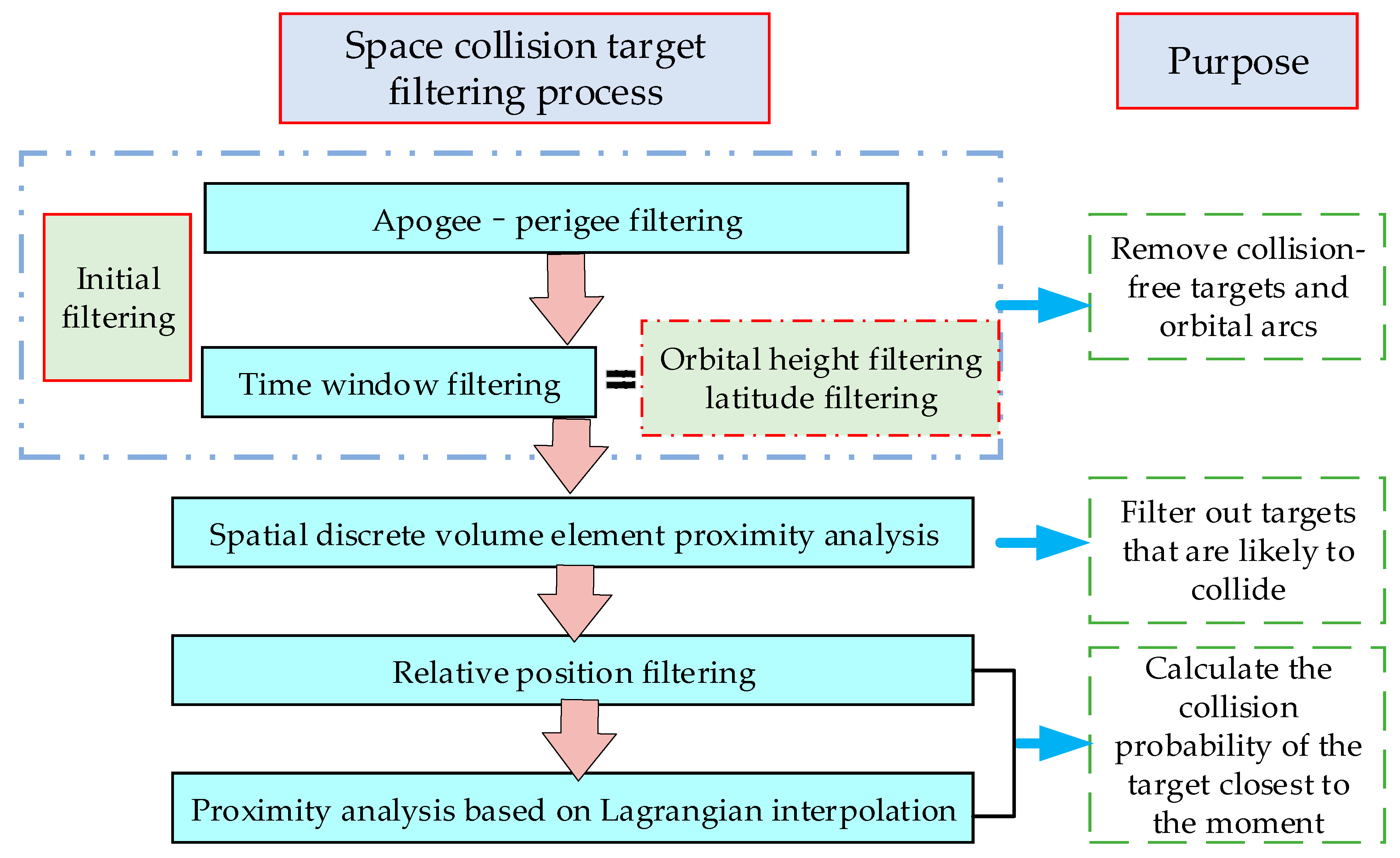
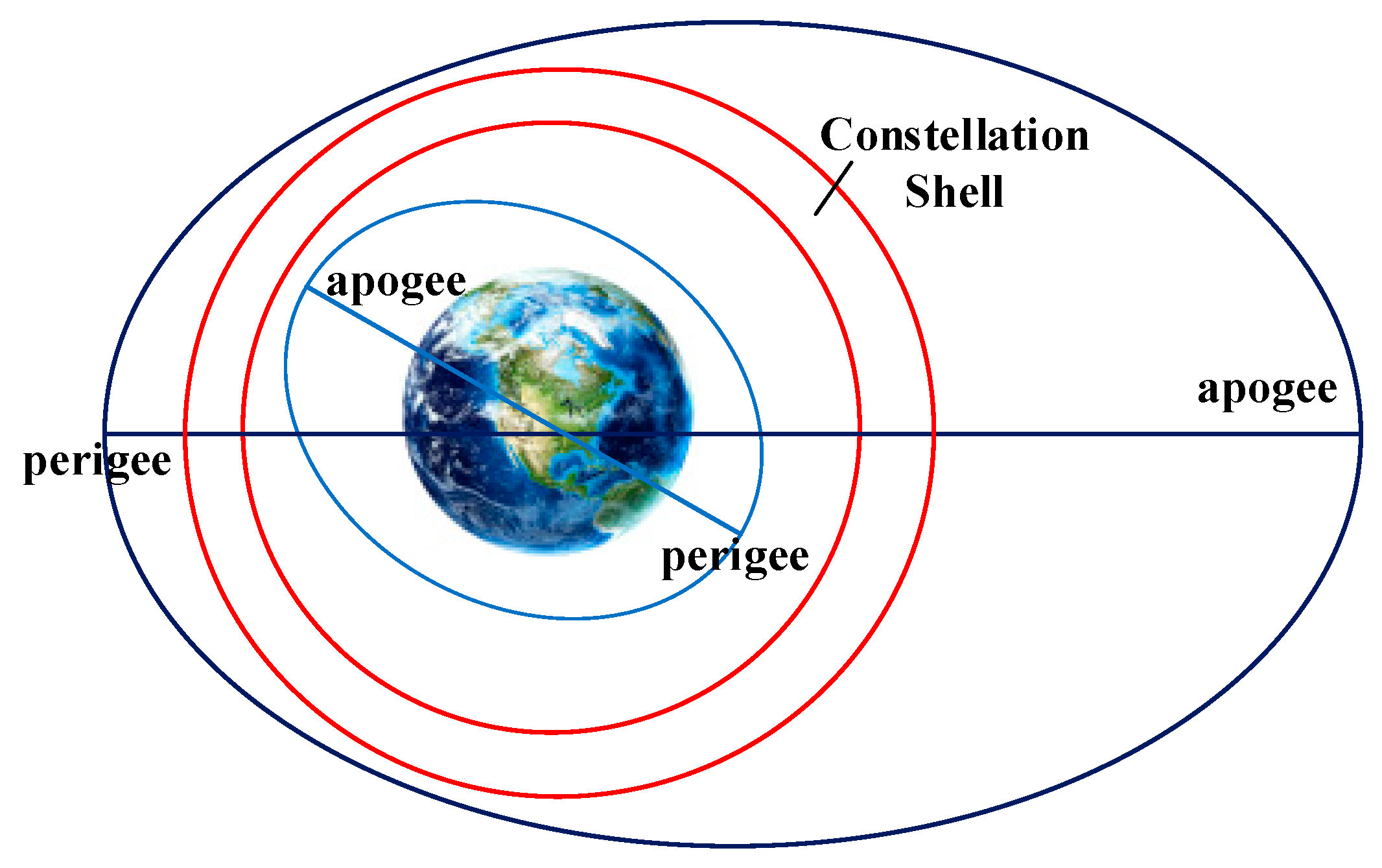

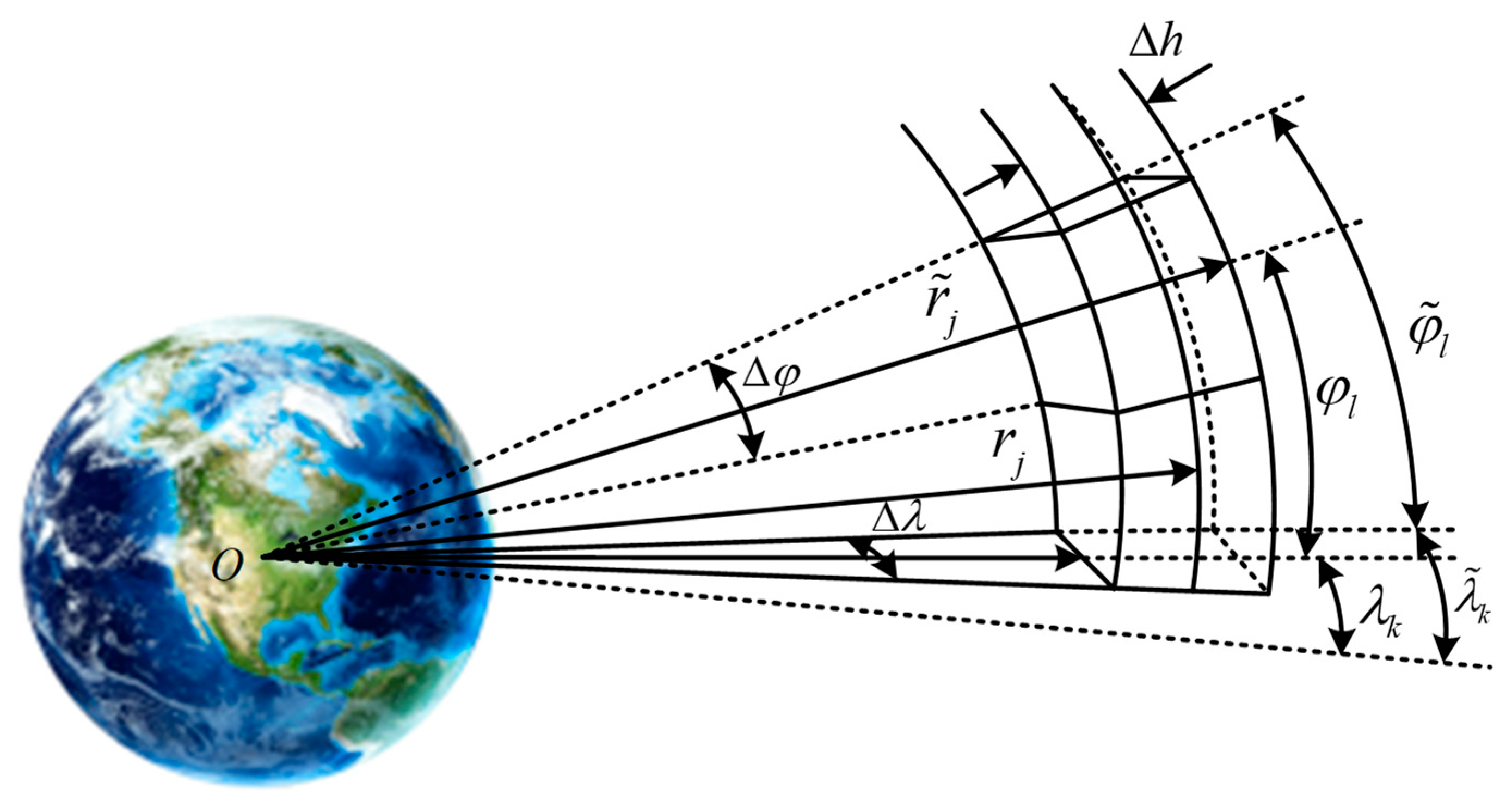
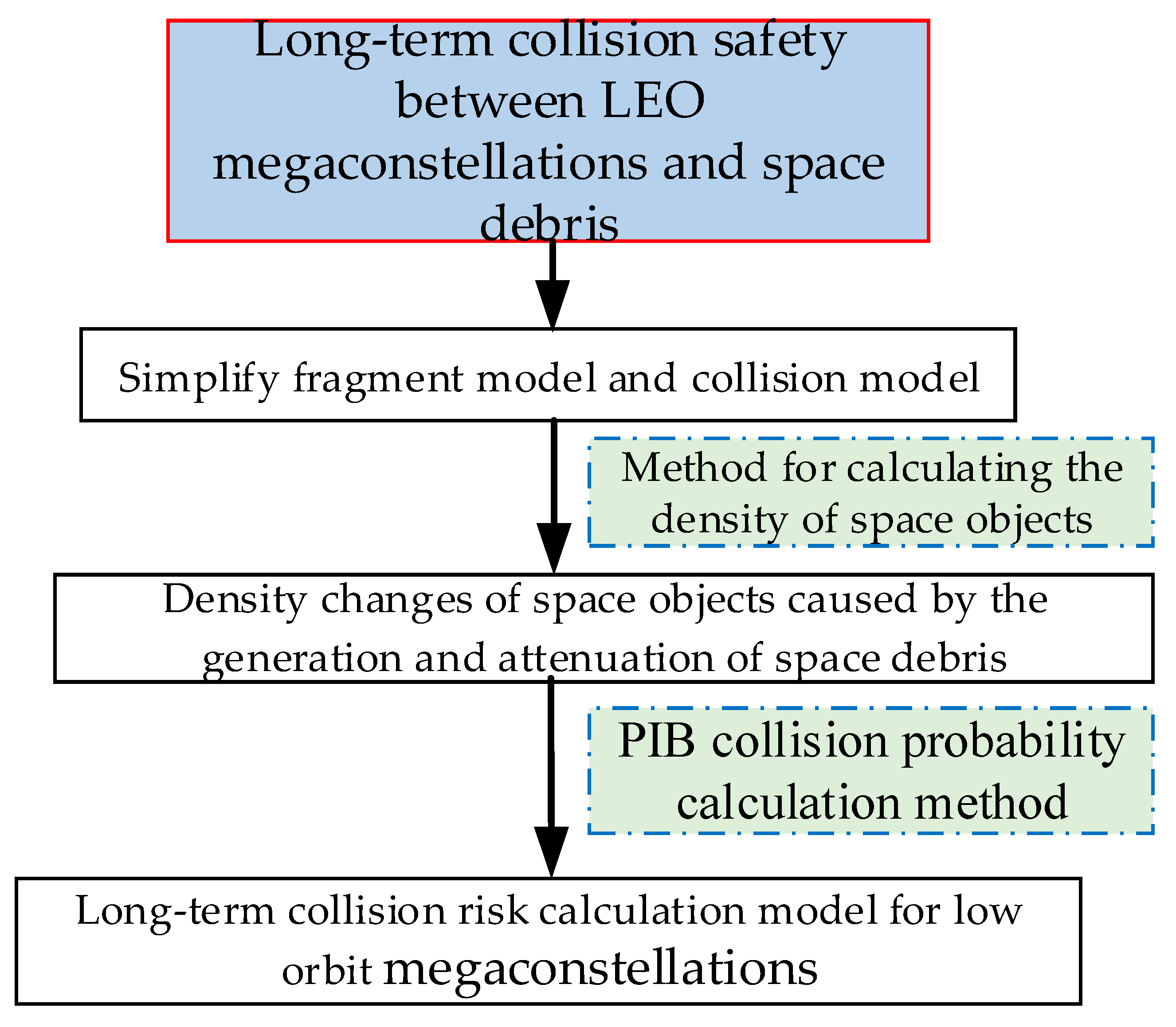
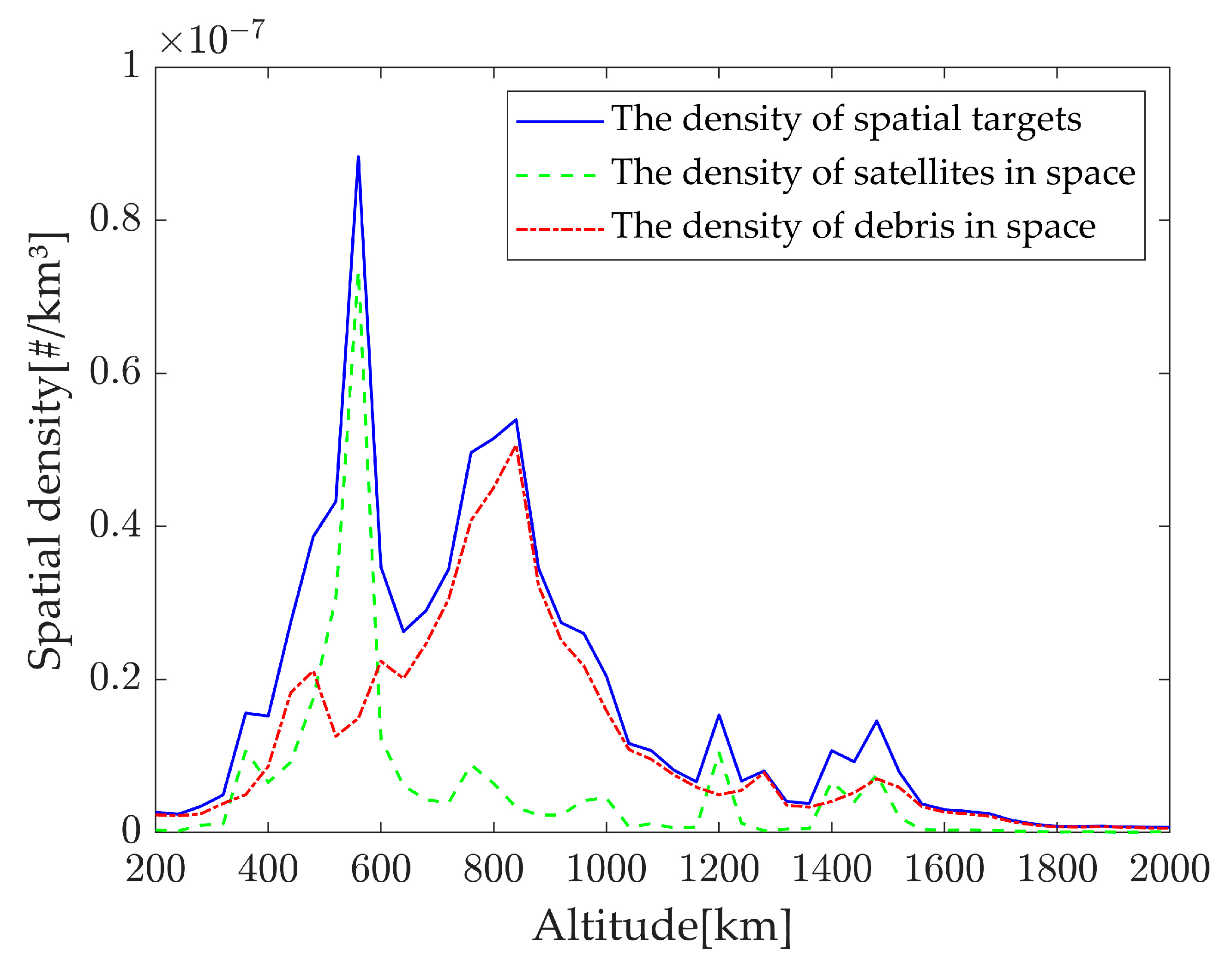
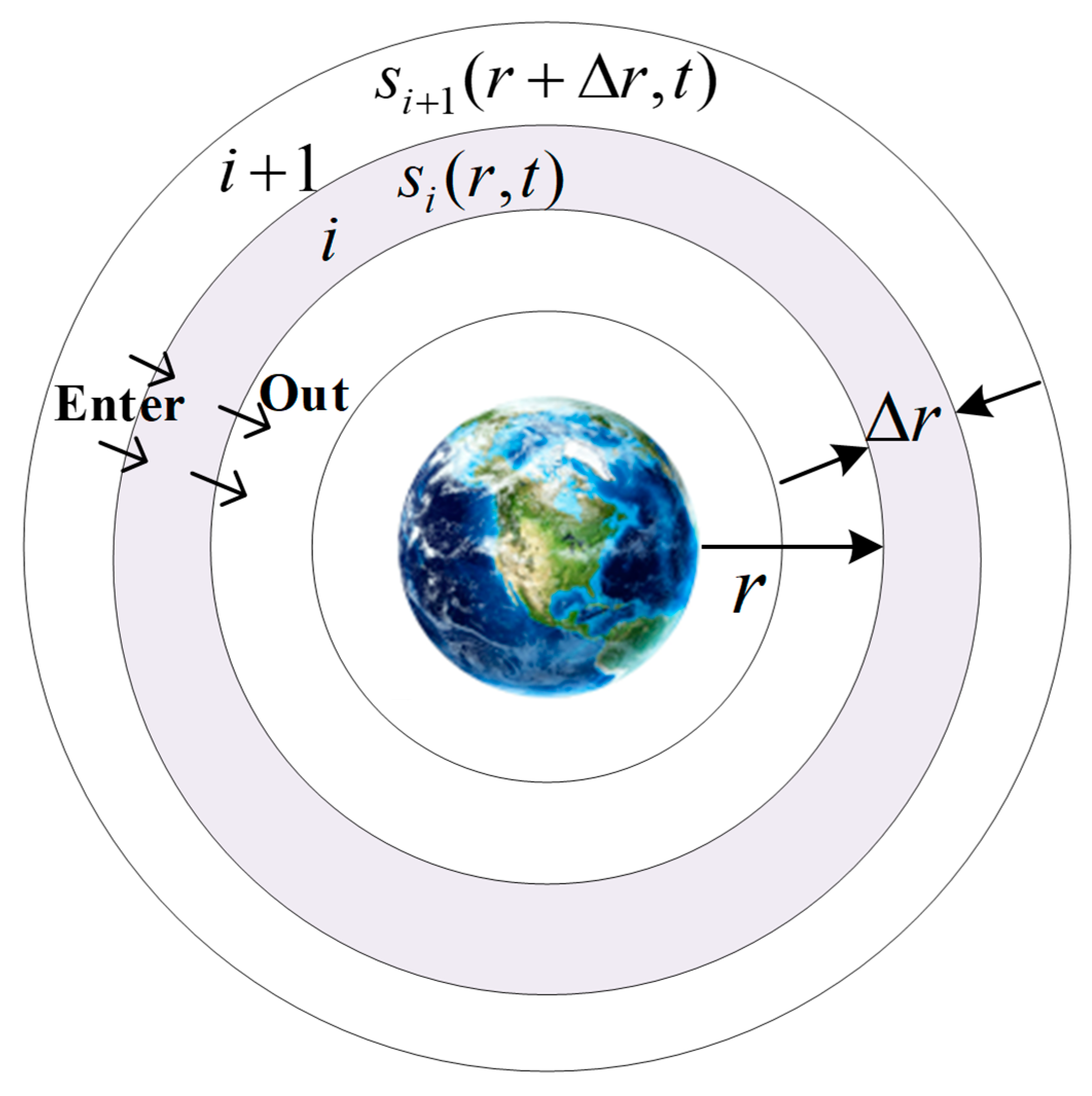
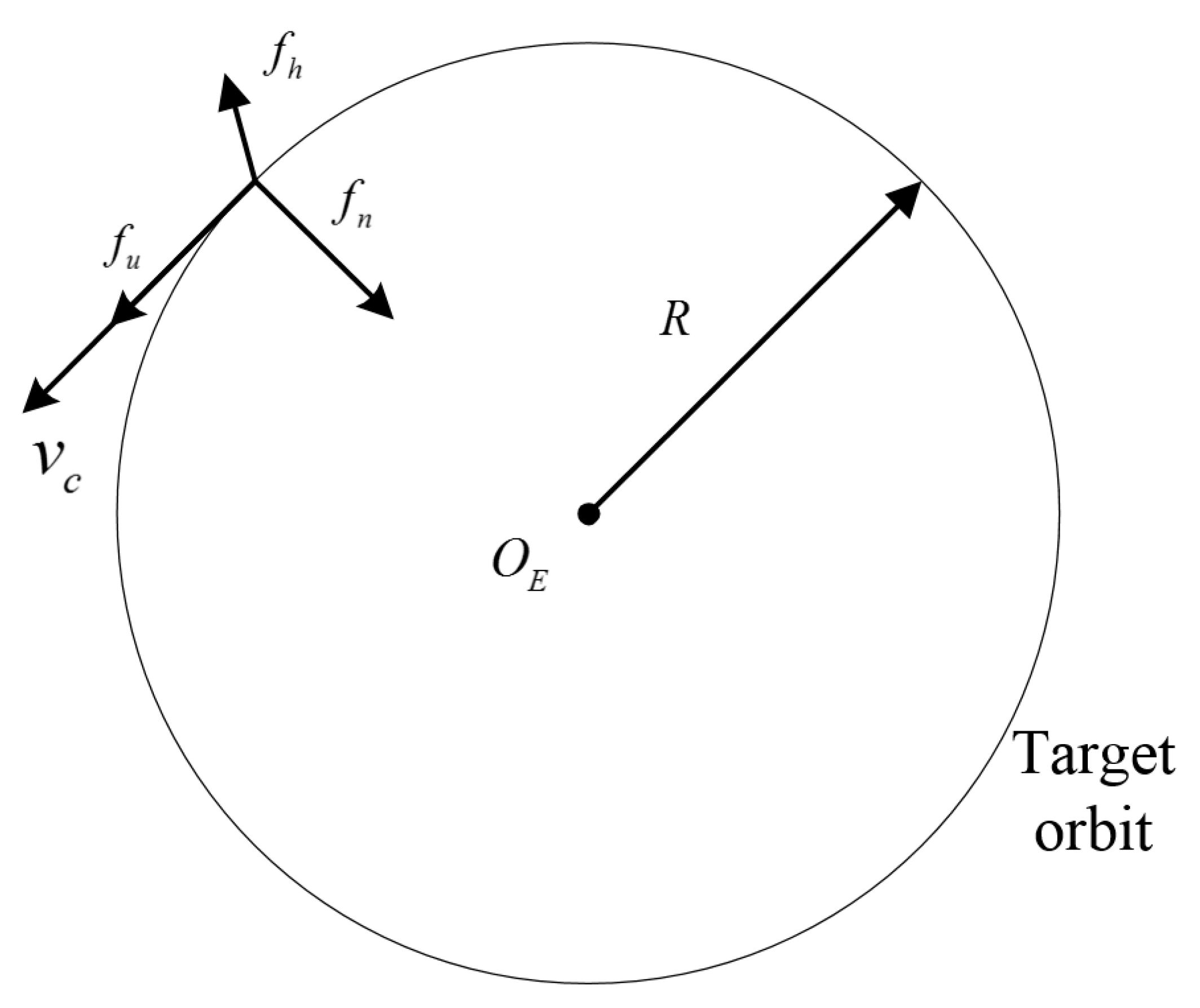



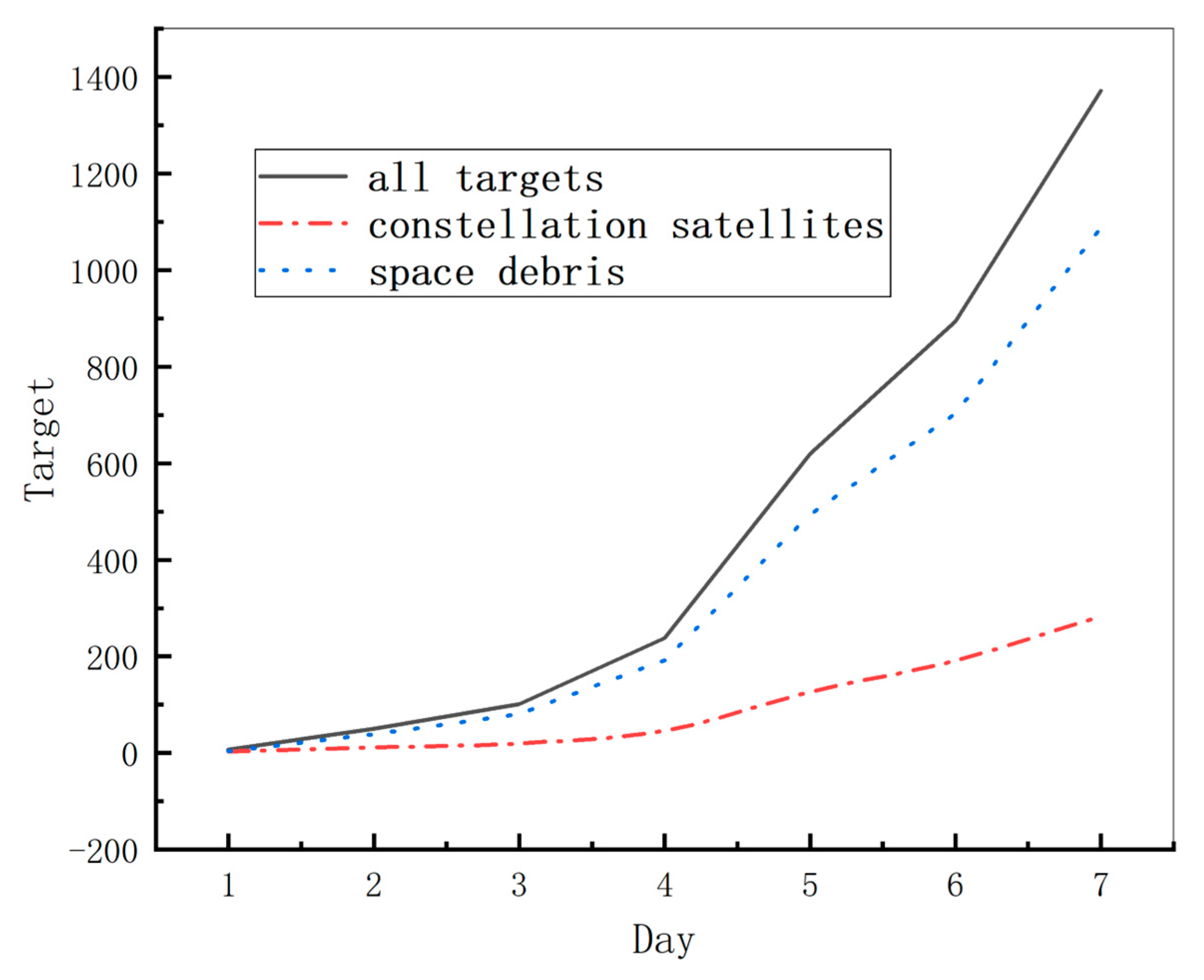

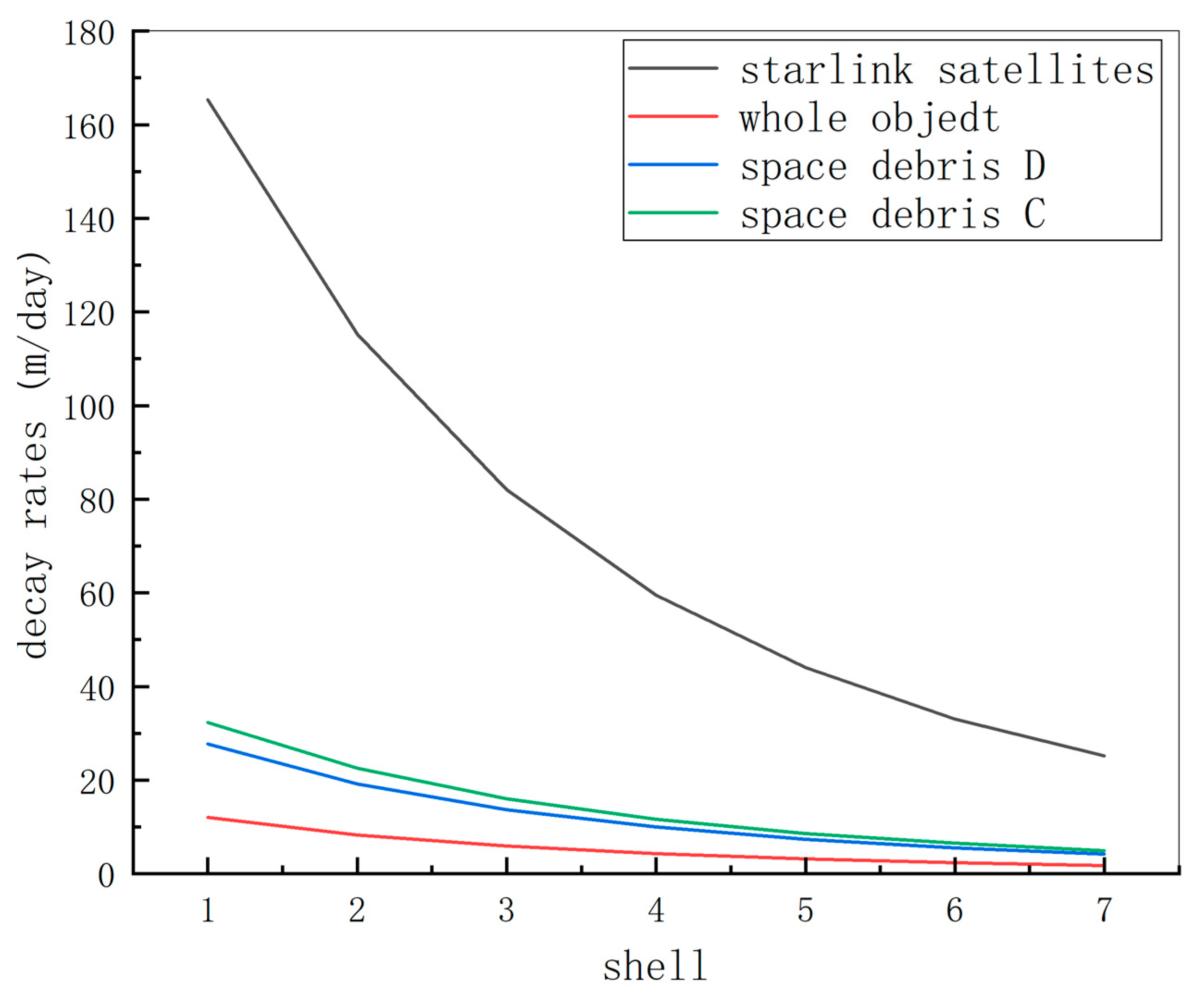

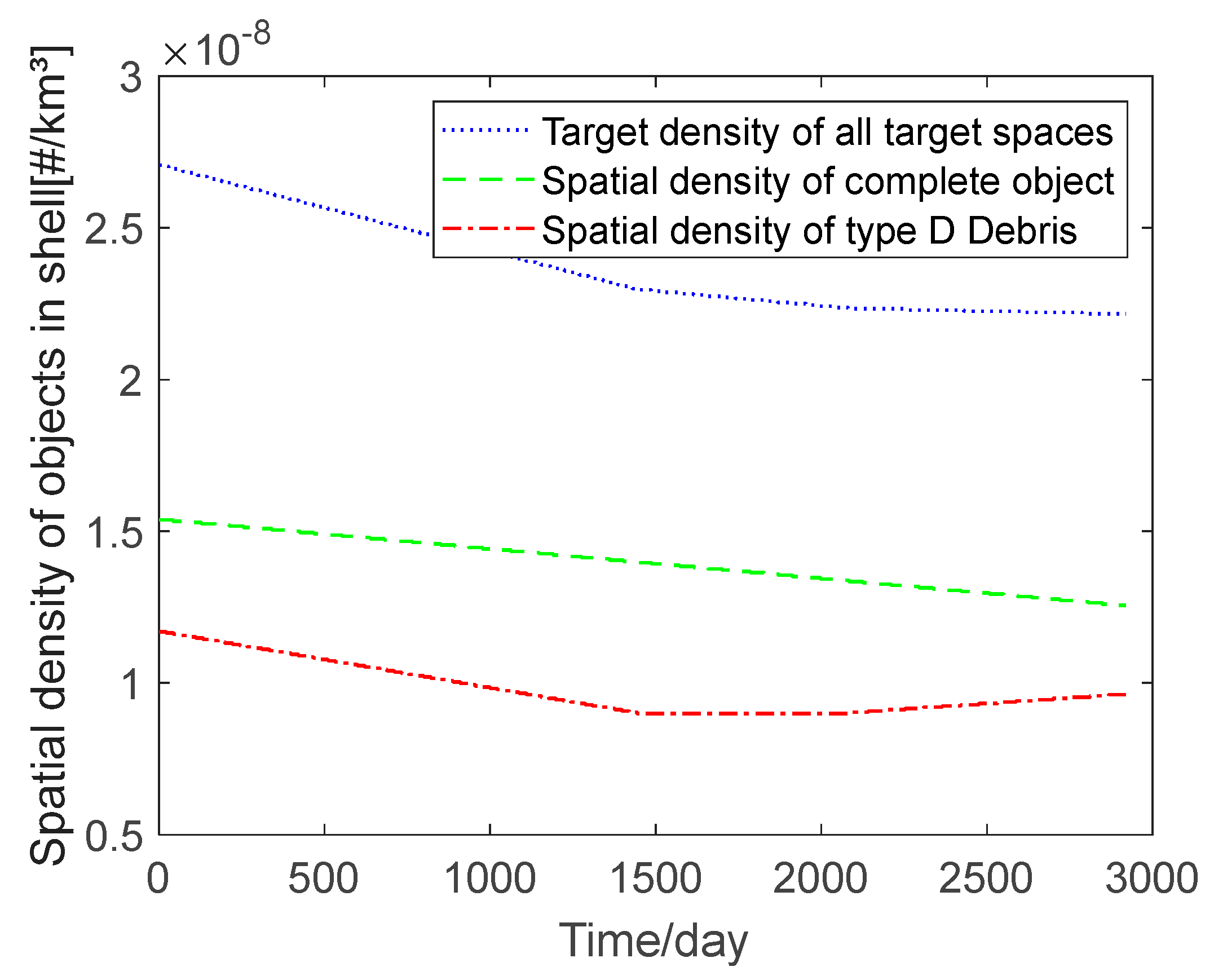
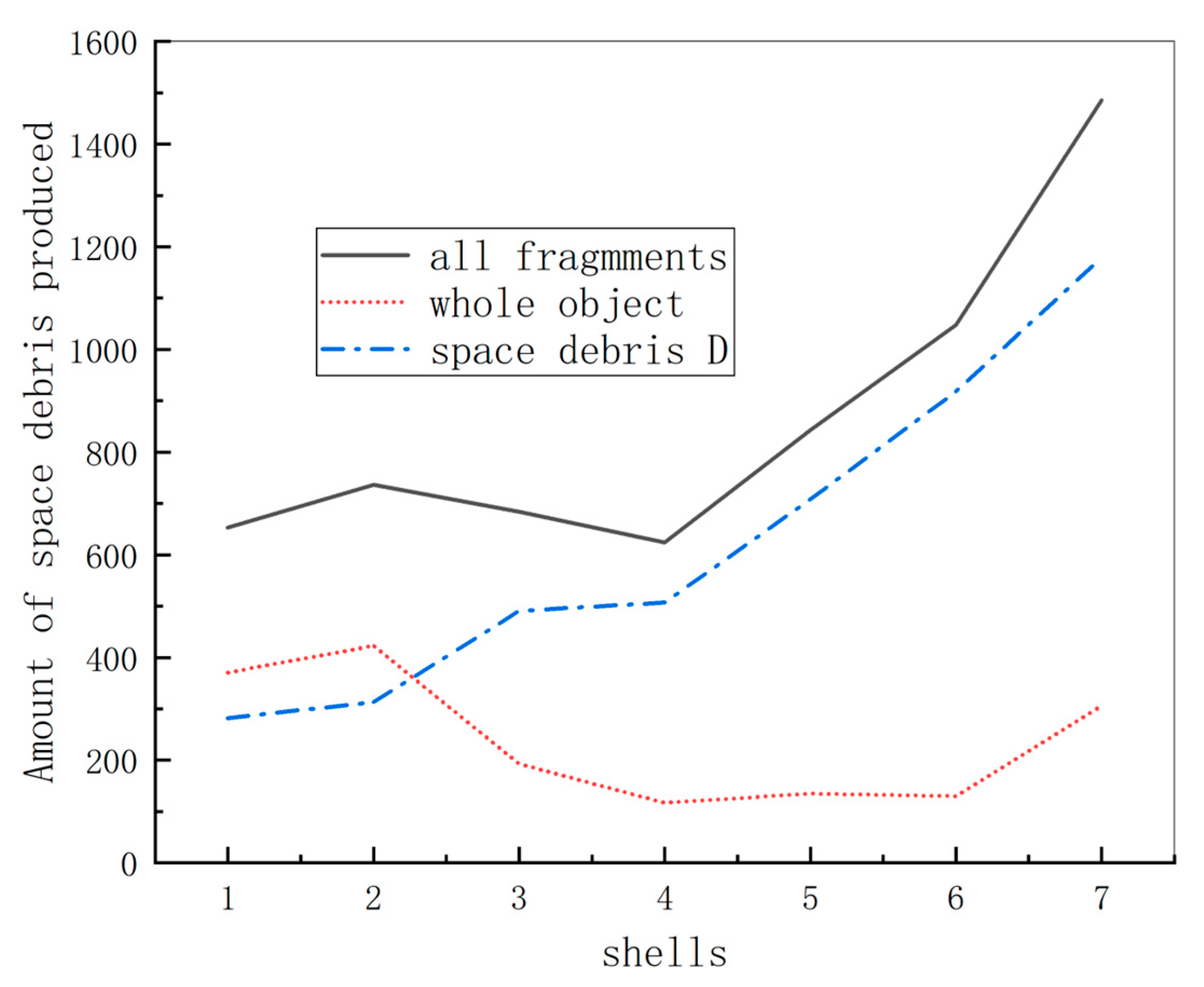
| Constellation | Orbit Altitude/km | Number of Satellites |
|---|---|---|
| OneWeb | 1200 | 7020 |
| Starlink | 328–614 | 41,926 |
| Kuiper | 590–630 | 3236 |
| Telesat | 1015–1325 | 1671 |
| Boeing/LEO | 1200 | 2956 |
| Close Target Type | Day One | Day Two | Day Three | Day Four | Day Five | Day Six | Day Seven |
|---|---|---|---|---|---|---|---|
| Number of times close to all targets | 7 | 50 | 101 | 238 | 620 | 894 | 1371 |
| Number of times close to constellation satellites | 3 | 11 | 20 | 46 | 126 | 191 | 283 |
| Number of close encounters between space debris objects | 4 | 39 | 81 | 192 | 494 | 703 | 1088 |
| Collision Target Type | Day One | Day Two | Day Three | Day Four | Day Five | Day Six | Day Seven |
|---|---|---|---|---|---|---|---|
| Between constellation satellites | 0 | 0 | 0 | 0 | 0 | 0 | 0 |
| Between constellation satellites and space debris | 1 | 3 | 7 | 6 | 3 | 3 | 1 |
| Between space debris | 2 | 12 | 23 | 17 | 13 | 8 | 4 |
| Target Type | Shell One (m/day) | Shell Two (m/day) | Shell Three (m/day) | Shell Four (m/day) | Shell Five (m/day) | Shell Six (m/day) | Shell Seven (m/day) |
|---|---|---|---|---|---|---|---|
| Starlink satellites | 165.4 | 115.2 | 82 | 59.5 | 44 | 33 | 25.2 |
| Whole object | 12 | 8.3 | 5.9 | 4.3 | 3.2 | 2.4 | 1.8 |
| Space debris | 27.7 | 19.2 | 13.7 | 10 | 7.4 | 5.5 | 4.2 |
| Space debris | 32.3 | 22.5 | 16 | 11.6 | 8.58 | 6.5 | 4.9 |
| Target Type | Shell One | Shell Two | Shell Three | Shell Four | Shell Five | Shell Six | Shell Seven |
|---|---|---|---|---|---|---|---|
| All fragments | 653 | 736 | 684 | 624 | 843 | 1048 | 1485 |
| Whole object I | 371 | 423 | 193 | 117 | 135 | 130 | 306 |
| Space debris D | 282 | 313 | 491 | 507 | 708 | 918 | 1179 |
| Collision Target Type | Space Debris Number | Space Debris |
|---|---|---|
| Starlink satellites and intact objects | 624 | 17 |
| Starlink satellites and space debris | 65 | 132 |
| Starlink satellites and space debris | 64 | 132 |
| Whole objects and whole objects | 1643 | 385 |
| Intact objects and space debris | 466 | 74 |
| Intact objects and space debris | 465 | 74 |
Disclaimer/Publisher’s Note: The statements, opinions and data contained in all publications are solely those of the individual author(s) and contributor(s) and not of MDPI and/or the editor(s). MDPI and/or the editor(s) disclaim responsibility for any injury to people or property resulting from any ideas, methods, instructions or products referred to in the content. |
© 2024 by the authors. Licensee MDPI, Basel, Switzerland. This article is an open access article distributed under the terms and conditions of the Creative Commons Attribution (CC BY) license (https://creativecommons.org/licenses/by/4.0/).
Share and Cite
Ruan, Y.; Hu, M.; Yun, C.; Xue, W. Preliminary Safety Analysis of Megaconstellations in Low Earth Orbit: Assessing Short-Term and Long-Term Collision Risks. Appl. Sci. 2024, 14, 2953. https://doi.org/10.3390/app14072953
Ruan Y, Hu M, Yun C, Xue W. Preliminary Safety Analysis of Megaconstellations in Low Earth Orbit: Assessing Short-Term and Long-Term Collision Risks. Applied Sciences. 2024; 14(7):2953. https://doi.org/10.3390/app14072953
Chicago/Turabian StyleRuan, Yongjing, Min Hu, Chaoming Yun, and Wen Xue. 2024. "Preliminary Safety Analysis of Megaconstellations in Low Earth Orbit: Assessing Short-Term and Long-Term Collision Risks" Applied Sciences 14, no. 7: 2953. https://doi.org/10.3390/app14072953
APA StyleRuan, Y., Hu, M., Yun, C., & Xue, W. (2024). Preliminary Safety Analysis of Megaconstellations in Low Earth Orbit: Assessing Short-Term and Long-Term Collision Risks. Applied Sciences, 14(7), 2953. https://doi.org/10.3390/app14072953





